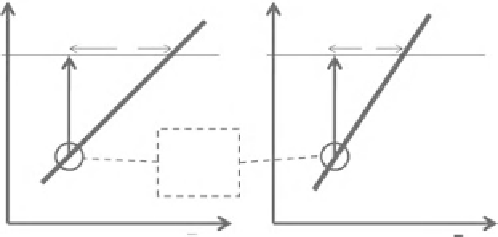Geoscience Reference
In-Depth Information
Figure 19.4
The movement
within a turbulent field of a
parcel of air from level
z
Height
Height
to
z
,
bringing with it the mean
humidity and wind speed
relevant at level
z
′. Note that
in this diagram mean
humidity is assumed to
increase with height for
consistency with the profile
for wind speed, but the
converse is more usually the
case over moist surfaces in
daytime conditions.
′
q
'
u
'
z
z
z
'
z
'
Same
parcel
of air
q
u
Mixing length theory
To complete a K Theory based closure scheme, it is necessary to prescribe a
functional form to the values of eddy diffusivity. Observations suggest that when
K Theory is applied in the surface layer the values of the eddy diffusivities depend
on the aerodynamic properties of the underlying surface and change with
atmospheric stability. The relationship to surface aerodynamics is explored next
and the effect of atmospheric stability considered in the next chapter.
The following discussion refers to turbulent transfer in neutral conditions in the
surface layer, i.e., when all of the turbulent kinetic energy is mechanically generated
and there is no sensible heat flux (strictly no buoyancy flux) to give buoyant
production. In these conditions the potential temperature gradient (strictly virtual
potential temperature gradient) is zero.
Consider now the movement of a parcel of air upward by amount
z
to reach the
level
z
which is caused by a positive fluctuation in vertical
w
ind speed
w
′
, as shown
i
n
Fig. 19.4. The parcel brings with it the mean humidity
q
and mean wind speed
u
from (
z - z
′
). It follows that the fluctuations
q'
and
u'
so caused at level
z
are
respectively given by
′
⎛⎞
∂
=−
⎜⎟
q
(19.7)
q
¢
z
¢
∂
⎝⎠
and:
⎛⎞
∂
=−
⎜⎟
u
(19.8)
u
¢
z
¢
∂
⎝⎠
Assume also that fluctuations in horizontal and vertical wind speed are correlated,
i.e. that:
wcu
¢
=−
¢
(19.9)






